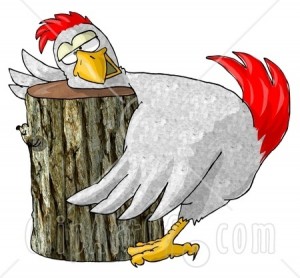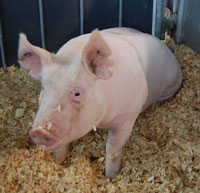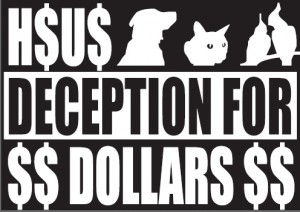Posted By Ken November 4, 2010
One of the chief arguments used by opponents of Proposition B in Missouri, which passed by a small margin in Tuesday’s election and restricts the size of dog breeding facilities and places burdens on them it exempts others from, was that it was a “foot in the door” for the Humane Society of the United States that would lead to similar regulations against livestock and other animal ag sectors in the state. That’s why its opposition was so broad for what could have been a very simple measure had it been worded right.
HSUS and its allies insisted all along it is just about the puppies and that agriculture is over-reacting in seeing a threat.
This morning, less than two days after Prop. B won, we see who was right. The groundwork is already being laid for extending HSUS influence in the Show-Me State, in the form of the popular comic strip Mutts – which has not only placed HSUS’s Wayne Pacelle on a pedestal in the past but actively promoted Proposition B before Tuesday’s election.
Didn’t take very long, did it now?

Posted By Mark October 22, 2010
 Years ago I wrote a blog asking what “happy chicken” tastes like. It was in response to a small but growing number of people who preferred free range chicken. The theory being that it was more humane letting them roam and fend for themselves than living in a building or in a cage.
Years ago I wrote a blog asking what “happy chicken” tastes like. It was in response to a small but growing number of people who preferred free range chicken. The theory being that it was more humane letting them roam and fend for themselves than living in a building or in a cage.
Funny thing is that chickens have a pretty strong menu avoidance mechanism. In much of farm country free range chickens are referred to as coyote hors d’oeuvres. Most are smart enough not to wander to far from people and they head for the chicken house before dark because of the aforementioned coyote and or fox. And truth is we can’t feed a hungry world with these old school methods.
In today’s New York Times William Neuman says, “shoppers in the supermarket today can buy chicken free of nearly everything but adjectives… free-range, cage-free, antibiotic-free, raised on vegetarian feed, organic, even air-chilled….coming soon stress free.”
The stress is eliminated by a new process that puts them to sleep with carbon dioxide prior to slaughter. My immediate reaction was to think of about three inappropriate jokes/references but then I read further to see that Temple Grandin, a renowned professor of animal science at Colorado State University and a prominent livestock expert, helped design the system.
There are other experts who note most of the time people don’t want to think about where their food comes from or how the animal was killed which may in itself be a problem. In fact those opposed to animal agriculture use this as a tool to shackle and inhibit the industry. They show video footage of inhumane examples of animal treatment and slaughter that are not the norm.
The same experts argue to fight back in this image war we should show consumers a real farm, a real high-tech and modern slaughter facility. Research does show that this kind of exposure might make someone stop eating hamburgers or chicken but they get over it in a matter of days. Afterwards they get inoculated to future attempts to shock them by these animal rights groups.
This I do know; with few exceptions livestock from hogs to chickens are cared for well and humanely. Many live in climate controlled environments, they see a doctor/vet more than I do, and humane husbandry is the rule. This too I know; if our trend towards food with lots of adjectives describing it continues you will pay lots more for food.
Posted By Mark October 13, 2010
 Today’s guest blogger is Jeff Fowle a fourth generation family farmer and rancher from Etna, California. He also writes a blog called Common Sense Agriculture.
Today’s guest blogger is Jeff Fowle a fourth generation family farmer and rancher from Etna, California. He also writes a blog called Common Sense Agriculture.
I am writing in response to the opinion piece that was published in your Lifestyle section on October 11, 2010. It is sad that you would publish an article by an animal rights activist that paints every farm, ranch and animal facility with one broad brush of inaccuracy and fallacy. The vast majority of farmers and ranchers treat their animals humanely and respectfully. As a rancher and an active animal welfarist, I would like to share the following thoughts.
First, this is a personal issue for family farmers and ranchers like me. We consider our animals a part of our family and often spend more time caring for our animals than we spend with our families. We make sure our animals have the highest quality food, water and veterinary care; health is paramount. We also do our best to protect our animals from disease, competition, injury and predators.
Second, the writer makes it sound as though these practices are typical. Those of us involved in farming and ranching know that is not so. Without healthy, content animals, farmers and ranchers could not stay in business. We understand the importance of animal care in assuring safe and high-quality meat, milk and eggs for our communities. Some of us personally know our consumers, others do not, but we always make it a priority to ensure that the food we are raising is the best cared for and of the highest quality.
Third, farmers and ranchers are as disgusted as anyone by the abuse alleged in this opinion piece. If people are abusing animals, they should be prosecuted to the full extent of the law. One incident of mishandling is one too many. There must be zero tolerance for inhumane animal treatment, period.
There are a lot of dedicated people who specialize in animal care, people like veterinarians, animal scientists and experts on animal well-being. Farmers and ranchers have been actively working with them to create quality-assurance programs that set guidelines for animal handling to eliminate stress, decrease risk of injury (to both animal and human) and ensure the highest quality of animal products for American consumers.
In closing, as a family rancher, I thank you for the opportunity to respond as an individual who depends on ensuring the health and welfare of the livestock I raise to be able to continue to provide a high quality, safe, wholesome and nutritious product.
Farmers and ranchers across the United States are telling their stories through videos, blogging and photos. Consumers can connect with them to see how they care for their animals and raise the safest food possible at http://www.agchat.org. You can contact Jeff here.
Posted By Mark October 1, 2010
 Ribeyes and bacon and wings oh my! In case you missed it, today is World Vegetarian Day, the annual kick off of Vegetarian Month. The effort even has a web site to try to convince you of the benefits of the practice of going meatless.
Ribeyes and bacon and wings oh my! In case you missed it, today is World Vegetarian Day, the annual kick off of Vegetarian Month. The effort even has a web site to try to convince you of the benefits of the practice of going meatless.
There they say vegetarianism helps to create a better world because vegetarian diets have proven health benefits, save animals’ lives and help to preserve the Earth. I won’t debate the obvious holes in this sweeping litany of benefits but rather just say since when did my hamburger become a social issue?
They are even offering prizes of up to $1,000 to try to go meat free for a month. The web site comes complete with sign up cards to give to your friends. Have to admit I stopped and thought about it for a second. That much scratch would buy a lot or pork chops and filets.
Some people agree with a few of these vegetarian contentions and continue to eat meat for the simple reason that meat is good and provides pleasure at a very fundamental level.
Personally, I have the physical tools from teeth to the appropriate omnivorous body parts to eat meat and two millions years of experience in my genes so I think I will spend my energy trying to eat the balanced diet nature intended including meat and more fruits and vegetables.
Posted By Mark September 13, 2010
The Humane Society of the United States (HSUS) is the single biggest enemy facing animal agriculture today, according to the Center for Consumer Freedom. Family farmers who are at ground zero in livestock production and consumers who enjoy meat as part of a healthy diet need to fight back now.
Their goal isn’t to directly turn us all into vegetarians/vegans but rather to make meat so expensive even meat lovers will cut their intake dramatically. For hard core vegans not eating meat is an ethical choice but under HSUS’s plan depressing sales is the objective. David Martosko, CCF’s director of research, told the St. Louis Ag Club today that cutting meat demand 10-15% by would be enough to put the industry in a tailspin.
Efforts to achieve this goal are well underway with an entire generation of consumers being hit with propaganda in schools and emotional messaging through the media. He estimates HSUS already has a mailing list reaching 12% of U.S. consumers and given time their aggressive tactics will make converts unless the other side takes action.
Martosko says both and offensive and defensive strategies are needed. Farmers telling an accurate story of modern animal husbandry is the defensive part. Giving the public a peek at the real HSUS, going after their good public opinion, is the offensive part. The organization’s credibility is off the charts, Martosko says ,with an 83% public approval rating. Without exposure to HSUS’s questionable mission and business practices they will only be rivaled by the American Red Cross.
Once this happens it is time to close the barn door on public opinion because the cow has left the barn. He says we already be three to five years out from this goal being reached.
Chris Chinn, whose family raises hogs near Clarence, Missouri, has already mastered the defensive part of the formula. She spends an increasing amount of time speaking to the public directly and via Social Media. Chinn challenges anyone who cares about the future of agriculture to find 10 non-farm friends and educate them on the real HSUS and ask them to spread to word.
Here are a few tidbits you might find useful in exposing HSUS:
Less than 1% of HSUS’s massive war chest goes to help or rescue animals through shelters (.45% of their budget to be exact). Give to your local shelters if you want to help.
When you donate to help pets keep in mind HSUS puts 5 times more money into its pension fund than what they spend on local humane shelters.
Their end goal isn’t to eliminate suffering by animals but to eliminate the sufferer. HSUS assumes all animals are raised in an inhumane fashion.
Currently 59% of the public thinks HSUS donations go to help shelters and animals directly. Think again. HSUS will spend more money on payroll this year than President Obama’s White House.
HSUS generates $132 in revenue annually yet produces nothing, has no inventory and has $52 million in petty cash for marketing and lobbying.
To learn more go to www.humanewatch.org
Posted By Cindy August 18, 2010
In case you missed it, Tuesday night’s Colbert Nation is must see TV for meat eaters.
American Meat Institute (AMI) President J. Patrick Boyle was the main dish on comedian Stephen Colbert’s “Know Your Lobby” segment, which profiles lobbying organizations.
“Although I’ve had a lot of tough interviews in my day, that was definitely the toughest and most unique interview experience of my career,” Boyle said. “I was honored to play straight man to the hilarious Stephen Colbert and to demonstrate that while meat processing is serious business, we can be good sports.” AMI reports that Boyle’s interview with the comedian was two hours long, edited down to a four minute segment for the show.
Colbert’s intro to the interview features him “pledging allegiance” to a bacon flag: “I pledge allegiance to the meat of the United Steaks of America. And to the ribeye for which it broils, one bacon under God, with liver and onions for all!”
Chomping down on a huge turkey leg, Colbert confounds Boyle with questions like, “At what point will the AMI say ‘stop America, that’s the perfect amount of meat’?” and “Who’s pooping on our meat?” Colbert’s pièce de résistance comes when he asks (hypothetically, of course) if AMI would endorse the eating of people if there were no more animals. “The American Meat Institute would not support a policy of cannibalism,” says Boyle with a straight face. “We would not recommend humans for human consumption.”
Tongue planted firmly in cheek, it is pretty darn funny.
Watch it here on line.
Posted By Mark July 8, 2010
Many of our livestock producers today are family owned and operated ventures that make their animal’s care, health,  and comfort a priority. In this age of worst case scenarios getting the limelight it was refreshing to come across a very accurate and honest view of the nation’s livestock producers.
and comfort a priority. In this age of worst case scenarios getting the limelight it was refreshing to come across a very accurate and honest view of the nation’s livestock producers.
Given the extreme stories, messages and views that pound us every day from dozens of information sources in this wired world, I think we all need a reprieve. We all need places to go for perspective and this is particularly true regarding livestock production. Given the antics of lobbying groups like the Humane Society of the U.S., that disguise themselves as an animal welfare group, journalists like Michael Pollan giving advice on feeding cattle, and chef’s promoting specific crop and livestock rearing practices with no real education on the subject..it makes me want to scream.
Type the letters “Mi” into Google and Pollan’s name pops up and this crank - possibly well-meaning but still a crank – comes up immediately showing the influence he is having on society via the New York Times Best Seller List, rather than logging years nurturing cows or sweating in a cattle feedlot.
All of the above scenarios are roughly equivalent to going to a plumber for advice on brain surgery. I would certainly prefer to know my meat/protein comes from well managed family operations like David Fremark’s in St. Lawrence, South Dakota or Jamie Willret of Malta, Illinois referenced in the above blog. You will find farmers and ranchers outside the city limits of most any town or city. In fact these days you can find many of them as close as your laptop or smart phone via social media. #agchat on twitter is a great place to ask a question on almost anything related to farming and food production. I encourage you to start a dialogue.
Lack of knowledge on how livestock specifically and agriculture in general works is a huge risk for society today. Uniformed people make bad decisions and in this case potentially decisions that are irreparable as family farms don’t come back once they are gone.
Posted By Cindy June 24, 2010
 The ethanol by-product known as dried distillers grains, or DDGs, is being fed more often these days to all types of livestock. At first, it was mainly beef and dairy cattle producers that utilized the product, which is rich in protein, fiber and oil. Now more hog producers are using the product, which serves to recapture about one third of the corn that goes into making ethanol for the livestock feed market. Each bushel of grain used in the ethanol-making process produces about 18 pounds of DDGS.
The ethanol by-product known as dried distillers grains, or DDGs, is being fed more often these days to all types of livestock. At first, it was mainly beef and dairy cattle producers that utilized the product, which is rich in protein, fiber and oil. Now more hog producers are using the product, which serves to recapture about one third of the corn that goes into making ethanol for the livestock feed market. Each bushel of grain used in the ethanol-making process produces about 18 pounds of DDGS.
 Companies like Novus International are helping to increase the use of DDGs in pork production by researching how much DDGs can be included in hog rations at different ages for proper nutrition. “We’ve increased the inclusion rates of distillers from just a few years ago, somewhere around ten percent, now to 30-40 percent in some diets,” says Brad Lawrence, Technical Manager for the Novus pork business in North America.
Companies like Novus International are helping to increase the use of DDGs in pork production by researching how much DDGs can be included in hog rations at different ages for proper nutrition. “We’ve increased the inclusion rates of distillers from just a few years ago, somewhere around ten percent, now to 30-40 percent in some diets,” says Brad Lawrence, Technical Manager for the Novus pork business in North America.
During the recent World Pork Expo in Des Moines, Lawrence said that has fundamentally changed the nutritional content of the pig’s diet, so Novus did some modeling and research and found that including oxidative balance additives in the feed helped get optimum performance from the animals. “Ethanol is here to stay,” Lawrence said. “There’s some concerns about corn availability, but as we put corn into an ethanol plant, we’re getting distillers back out. As swine nutritionists, that means we have to learn what the optimum nutritional technologies are that we can implement to get the most value out of the distillers.”
Listen to an interview with Brad Lawrence from World Pork Expo here:
Posted By Guest Blogger June 16, 2010
 Guest Blog from Jennifer Elwell and her “Food, Mommy” Blog (More on the author at the bottom of the page)
Guest Blog from Jennifer Elwell and her “Food, Mommy” Blog (More on the author at the bottom of the page)
Back when I was a kid (we’ll say 20 to 30 years ago), vegetarians were few and far between and were often thought of as a little strange. Now, it seems, being a vegetarian or vegan is the “stylish” thing to do. More and more people of all ages are making the choice not to eat meat for reasons that make sense to them.
The majority of the population continues to eat meat because that’s what they have always done, as their parents did before them. As our ancestors figured out, eating meat is an easy way to get protein, and most of it just tastes good.
I put myself in a different meat-eating category. I have a made a very conscious decision, and I “choose” to eat meat. I know it comes from animals, and I realize those animals’ lives were cut short for my sustenance. This is something I think about each time I sit down to a meal, and I am grateful.
As a true lover of animals, I will admit that going meatless crossed my mind a couple times. I am the kind of person who never kills a spider, carefully removes creepy-crawlies from my home, and stops traffic to see a turtle or family of ducks safely cross the road. My taste buds and feeling of hunger satisfaction, however, quickly transformed me back into the omnivore that I am.
Now, one could ask how I can eat meat when animals are being mistreated (recent Conklin Dairy video would be a good example) or are forced to live in confined conditions. In my good opinion, acts of such mistreatment are few and far between, and I believe that anyone who abuses animals in this way should be punished as if they had assaulted a fellow human. Confinement, or as I like to think of it has a more controlled habitat, has become a necessary practice to meet demand. There are more people, less farmers and less land to produce these animals.
Do the animals like their confined conditions? Would they rather be running free? While I don’t have cows or chickens at the moment, I do have horses. It has been 90 degrees or higher the last several days. They have free run of the barn and a five acre pasture with lots of shade trees. I CANNOT MAKE them leave the confinement of their stalls. Why? The barn has a large fan and is generally free of all the blood-sucking bugs. They also know that I come to feed them twice a day. (more…)
Posted By Mark June 3, 2010
 If you are a row crop farmer who hasn’t raised livestock in years you might wonder how much energy and personal capitol you want to expend educating people about the anti-livestock efforts of the Humane Society of the United States. Besides the obvious large feed consumption, recent developments should have you even more concerned.
If you are a row crop farmer who hasn’t raised livestock in years you might wonder how much energy and personal capitol you want to expend educating people about the anti-livestock efforts of the Humane Society of the United States. Besides the obvious large feed consumption, recent developments should have you even more concerned.
Regular readers of this blog realize giving donations to your local animal shelters is a good thing. They actually help animals, unlike the loosely related Humane Society of the United States that gives nearly nothing to support these efforts. Instead, HSUS chooses to use its significant and questionably acquired resources to pursue an animal rights agenda and vegan lifestyle.
HSUS is systematically going from state to state trying to enforce their minority agenda by passing laws that would radically change safe, proven and productive livestock rearing practices. And they are leveraging their positive reputation – yes they have one because people think they are saving puppies – to tell farmers and ranchers how to do their job.
Their most recent effort in Ohio seemed to have ended well when voters showed them the door and told the carpetbaggers to go home. Ohio chose to form their own state board of experts to review, monitor and police livestock production practices.
This is where your radar should go up and the red lights should start flashing. HSUS is now trying to get an initiative on the November ballot that would force the state’s new Livestock Care Standards Board to mimic the policies that HSUS got passed with its last ballot measure, in California.
It appears the gathering of signatures wasn’t going well so HSUS sued the state of Ohio over a statute that was written to make sure only Ohioans could gather signatures to change state laws. HSUS remarkably won that suit.
This means groups like HSUS can now bring in paid, if not professional, employees to work the streets and gather the needed signatures to tell Ohio how to run their state. Given their past use of disingenuous images and information to acheive their goal, this does not bode well.
Personally, I am concerned other groups are watching the twisted success of HSUS and contemplating how this strategy might be applied to other issues and governing practices touching your profession and your day-to-day life. Precedence, even bad precedence, carries weight.
The good news is Ohio agriculture is working hard to assure a good outcome. In the interim, do your part by learning more about the real HSUS and tell your friends.
Page 3 of 6«12345...»Last »











 The ethanol by-product known as dried distillers grains, or DDGs, is being fed more often these days to all types of livestock. At first, it was mainly beef and dairy cattle producers that utilized the product, which is rich in protein, fiber and oil. Now more hog producers are using the product, which serves to recapture about one third of the corn that goes into making ethanol for the livestock feed market. Each bushel of grain used in the ethanol-making process produces about 18 pounds of DDGS.
The ethanol by-product known as dried distillers grains, or DDGs, is being fed more often these days to all types of livestock. At first, it was mainly beef and dairy cattle producers that utilized the product, which is rich in protein, fiber and oil. Now more hog producers are using the product, which serves to recapture about one third of the corn that goes into making ethanol for the livestock feed market. Each bushel of grain used in the ethanol-making process produces about 18 pounds of DDGS.  Companies like
Companies like 
